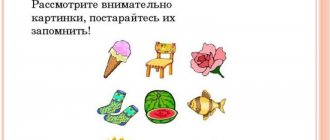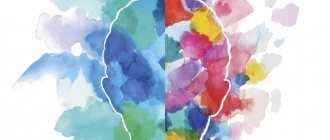0 306 April 27, 2020 at 04:16 pm Author of the publication: Marina Alekseeva
Imagination is a great gift that has contributed so much to the development of mankind.
Karl Marx
How to develop imagination? This question is most often asked by people in creative professions: artists, designers, photographers, writers, screenwriters. Imagination and fantasy are their daily working tools, without which it is impossible to create a new image, a bright work that leaves a lasting impression.
However, imagination is necessary in almost all areas of human life. Without it it is impossible:
- create something new;
- make discoveries in science;
- find a way out of hopeless situations;
- dream, set goals, plan and create the future;
- and even sell successfully.
Fantasy is equally necessary for an engineer and a scientist, a marketer and a salesman... and for any person who wants to expand the boundaries of existence, add color, enrich their life, and become successful.
Difference between imagination and fantasy
Imagination is a type of thinking when we create new ideas and images “in our head” based on the knowledge we have. Moreover, they are formed on the basis of real knowledge, that is, theoretically they can be brought to life. This is how imagination differs from fantasy.
When imagining, adults and especially children also come up with new, but still unrealistic, images and situations. Fantasy allows us to create absolutely any plot, even a fairy tale. To fantasize, you don’t need to take into account any physical laws and have great knowledge.
Let's say we need to solve a problem. Imagination will suggest a non-standard, but real and completely feasible solution, based on our experience and knowledge. But with the help of imagination we can solve it any way we want. There are no restrictions. Therefore, it is best for children to begin developing their thinking with fantasies.
Imagination in adults develops through expanding their horizons, accumulating information, experience and images. It has periods of recession and recovery. The latter are also called inspiration. However, scientists have come to the conclusion that inspiration most often comes to us during the work process, when we have already put in a lot of effort and work.
Image+image+action
Option similar to the previous one. Only two objects are connected by the action of the third.
Example. Linoleum + balcony door + ruler. Linoleum gallantly opens the balcony door with a ruler. The balcony door measures linoleum. The ruler walks the balcony door along the linoleum.
Another example. Mobile phone + bus + traffic light. A mobile phone winks at the bus like a traffic light. The bus calls the traffic light on its mobile: “Please turn it green!”
Here is a simple combination for independent work: Gift wrapping + display case + zebra crossing (pedestrian crossing).
What is imagination like?
There are different types of imagination.
- Recreating . It is based on experience. It is also called reproductive (reproducing). Imaginary images are based on existing phenomena and events.
- Creative . New images are created according to one’s own design, with virtually no recourse to experience. It is used practically in areas of human activity (science, art, technology, etc.).
According to the degree of activity, the following types of imagination are distinguished.
- Active . Using it, a person realizes invented images and ideas. It stimulates a person to actively create and therefore requires quite a lot of effort. Especially when newly created images are needed for professional activities (illustrators, writers, fashion designers, etc.).
- Passive . Does not stimulate a person to implement invented ideas. A person is simply satisfied with the result of his imagination. Or these ideas are not yet feasible in principle.
Creative thinking refers to active imagination. After all, the created ideas and images are subsequently implemented. But dreams are passive imagination. They in no way motivate a person to take active action.
A type of reconstructive imagination is spatial. It is used by humans in various fields of activity. Helps create new objects and images through the use of information about objects and space already available in memory.
Watch the course on developing imagination from Wikium.ru right now. And in general, register on the site, try different exercise machines. I recommend this project in almost every article about thinking, memory, communication between people, because it is really very good.
Development of creative perception
Creative perception itself is a type of some creative activity of the mind, during which completely new images are formed. They are based on stereotypes already in the mind. It is absolutely impossible to develop creative imagination without reading literature and making associations.
If there is a shortage of time, it is recommended to play special games that improve the development of imagination:
- Letters. You must choose any letter from the alphabet at your discretion, naming all the things that begin with it and located around it. By training in this way, a person develops memory and attention, as well as thinking and imagination. It is quite possible to imagine any missing items mentally.
- We name and describe. You will need to select any item and try to describe it more accurately. This technique not only promotes the development of creative abilities, but also enriches creative thinking.
By training daily for at least 20 minutes, you can get the desired effect:
- improve your own creativity;
- develop memory simultaneously with thinking;
- enrich yourself intellectually.
Techniques of creative imagination
Since ancient times, people have used special techniques to create new images. In ancient times, these techniques were used unconsciously. This is how epics, myths, and fairy tales were composed. And nowadays writers, artists and other representatives of creative professions use similar techniques.
- Agglutination . In another way it can be called gluing. A new image or character is created from two or more existing ones. For example, a centaur is half man and half horse. This is an example of simple agglutination. And it is found not only in works of art. Creators of new gadgets also use it, combining the functions of several in one device. For example, a phone with a camera function, etc.
- Hyperbole, litotes . In simple words – exaggeration and understatement. This is one of the simplest techniques for changing real images. With its help, you can transform not only the whole object, but also its individual parts. An example of litotes is Thumbelina.
- Accentuation . This technique is used to especially highlight a certain character trait. For example, in caricatures and cartoons.
- Personification . It consists of giving inanimate objects the characteristics of living beings. Most often found in fairy tales, for example, the talking apple tree and the stove from the fairy tale “Geese and Swans”.
- Typing . According to this principle, an image is created, assembled from typical features characteristic of a certain group of objects. Often used in literature and visual arts. For example, N.V. Gogol used the method to describe the types of landowners in the poem “Dead Souls”.
During the creative process, different techniques complement each other and mix. Thanks to this, it is possible to create unique images and find non-trivial solutions to problems. Both adults and children should master these techniques. And I’ll tell you how to do this further.
Ways to develop fantasy
Many adults are almost completely deprived of this quality. It is difficult for them to come up with tasks to develop their imagination, since they are not even able to compose a fairy tale for a child, come up with an interesting joke, draw a humorous picture, or create a carnival costume.
The fault is not a lack of talent - in fact, the problem is that a person does not know the techniques for developing his own imagination. It is necessary to perform special exercises to develop creative imagination, which help overcome the lack of imagination.
Developing a rhythm of attention
To perform the exercise recommended by methods of developing the imagination, you should completely relax, concentrate all your attention, directing it to your hands. Completely empty your skull, discarding any extraneous thoughts. Repeat this workout every day for 10 minutes, periodically changing your viewing angle or body position.
The main goal is complete concentration on the hands at the same time as the absence of any extraneous thoughts. It is allowed to blink, but it is not advisable to look away; just watch your hands.
Imprint
To develop imagination and good spatial imagination, find an object in the room that immediately attracts the eye. Then concentrate your attention on it for at least 5 seconds, taking a mental photograph of this thing.
Close your eyes, hold your breath for a few seconds, and try to reproduce what you saw in your memory. As you exhale, free your consciousness from the picture, as if erasing it from your memory. This is a good option for developing your creative imagination.
Photo manipulation
A good way to develop spatial imagination is to mentally imagine a specific object, which then needs to be moved in space, changing its dimensions and shape. Connect several objects together or split the whole picture into its individual fragments.
Move each mentally photographed object, change its shape, having previously determined the desired direction. You should train in this way until everything becomes easy.
Ability to see
Another option for recommendations regarding exercises for developing spatial imagination is training with matches. You need to prepare a couple of hundred matches. Find an assistant who will dictate certain words. You need to associate them with the appropriate way by laying it out from the matches. The exercise can be completed when you have managed to reproduce at least 50 words. After the dictation, you need to reproduce the words you heard out loud, looking at the combinations of matches. Using such options for developing imagination through different means, you will be able to achieve significant success.
Development of imagination in children
In general, approximately the same methods are used to develop imagination in children and adults. However, it is worth taking into account the characteristics of preschool age.
At preschool age, the psyche of children is most sensitive:
- children think primarily in images;
- open to everything new and unusual;
- their images are lively and colorful;
- they are free from stereotypes and thinking patterns that are characteristic of adults.
This refers to the undoubted advantages of the child's psyche. However, there are also negative features that are worth considering.
- Children do not yet have in their memory a large amount of information necessary for the formation of imagination. Therefore, to begin with, it is better to begin to develop imagination and perception. Teach your child to be observant and notice the unusual in simple things.
- Kids get tired quickly and are often distracted. It is difficult for them to engage in mental activity for a long time and concentrate on one thing. Any developmental activities should be enjoyed by the child and carried out with great desire. And the best way to develop imagination is, of course, games and reading books.
We, adults, with our example and enthusiasm can captivate a child - to play together, do exercises, fantasize and thus develop. Joint exercises during walks or long trips are especially effective.
Methods
The best way to develop a child’s imagination is to infect him with your own example. It should be interesting for a child to fantasize. Show him how great it is to come up with something new and unusual. The baby always strives to be like his parents and therefore imitates them in everything.
- Read books written in the fantasy genre together. It is necessary not only to read the work to the child, but also to discuss it and analyze it. For children under 7 years of age, it is best to read fairy tales and short fantasy stories. With a teenager you can already read more serious science fiction novels, for example, novels by Jules Verne, the Strugatsky brothers, etc.
- Ask your child unusual questions. For example, ask him what superpower he would like to have and why.
- Offer your child challenging tasks. For example, a child finds himself on a desert island. What does he have to do to survive?
Exercises
It is best to develop imagination by combining the methods proposed above and various exercises designed to hone creative thinking techniques.
- An animated drawing . Imagine that you have a special gift. Everything you draw will immediately come to life. Imagine with your child what you would like to breathe life into.
- Transformation . A person turns into a bird, an animal, an insect, a plant, into an inanimate natural object, into another person. What will he feel and do? This exercise develops empathy well - the ability to look at the world through the eyes of another object.
- Anthropomorphism . This method involves endowing animate and inanimate objects with human properties. For example, talking animals. Together with your child, come up with 10 similar examples. Together you can compose a fairy tale with invented images.
- A resident from another planet . Invite your child to draw an inhabitant of a distant planet, where living conditions are completely different from those on Earth. For example, the planet is completely covered in ice or the atmosphere consists of burning gases.
- New things . Invite your child to improve ordinary things by giving them new qualities or connecting them with each other. It can be anything: a comb, a toothbrush, a saucepan, a lamp, a pillow, etc.
- The giant and the short one . Imagine with your child that you have become the size of a 5-story building. What disadvantages and advantages will you have? What will you do? It is best to write a story based on this plot. And then imagine the opposite situation - you and your child are reduced to the size of a mouse. What will happen?
Simple exercises to train your imagination
Development of thinking in an adult and a child - recommendations
Psychologists offer many simple but effective exercises for developing thinking and flights of imagination that are suitable for people of all ages. Their main advantages are simplicity and accessibility. Everyone is able to find in the flow of information the exercise that will appeal to a particular person. For example:
- Counting in your head is accessible and interesting to everyone who has school knowledge. There is no need to use any notes, just count mentally. The exercise is especially useful for those who are good at mathematics. You can fantasize about geometric shapes, mentally building all sorts of combinations from them.
- Paradoxically, you can watch children's cartoons with your child and use them as a workout for your mind and imagination. It's helpful to watch them without sound and then come up with funny dialogue. The funnier the better for the imagination.
- The simplest way relates to the world of books. Reading detective stories or fantasy is becoming fashionable; it will benefit both imagination and fantasy.
- “Nonsense piggy bank”, where you can put interesting things: thoughts, pictures, ditties, jokes - everything that is considered nonsense. If necessary, you can always get an idea for a creative solution from there.
- Collective games are becoming fashionable, then it’s time to get some old-time fun out of the box. For example, "Pantomime", in which players must guess what action is being depicted. Creative imagination develops based on memory, since you need to remember what picture the participants are depicting.
Simple exercises will help your imagination fly
Development of imagination in adults
The imagination works most actively in adults, whose consciousness contains a large number of images. New images and ideas are born on the basis of existing information. And to accumulate rich experience you need:
- read books of different genres (fiction will be especially useful);
- visit exhibitions, museums;
- go to theater performances, movies;
- travel;
- communicate with different people;
- learn new skills.
Methods
To make your imagination work even more actively, use the following methods.
- Develop your powers of observation . Pay attention to everything around you: store signs, flower beds, building facades, and especially people. Take a closer look at passers-by or fellow travelers on public transport. What fate could they have? Make up a story or story about them.
- Get creative . You don't have to have talent to start creating. Drawing, writing poetry or prose, modeling - and this is not all that helps improve imagination. Throw templates and stereotypes out of your head! Invent and create your own unusual creations.
- Use your free time to daydream . When you are alone with yourself, start fantasizing. Imagination will quickly relieve boredom. Mentally picture your dreams. It's better than watching TV or scrolling through social networks. After all, you will be a creator, not a consumer.
- Look for new experiences . You can get them by learning a new activity, visiting places you have never been to before. You don't have to travel far to learn drawing, sewing, baking and other skills. All this is available in any city.
The more you use your imagination, the more solutions you will come up with for any problem. The thinking of a person without imagination is limited to narrow boundaries. It is difficult for him to come up with a non-standard solution to a problem, because he is used to thinking in stereotypes.
Exercises
I want to offer you some simple exercises to develop your imagination.
- Game "Crocodile" . I think you are familiar with this game. She is very funny and good for large groups. It also greatly develops creative imagination. Let me remind you of the rules. One participant whispers a word to the second participant. The second player’s task is to explain this word using gestures to the other players.
- Solving Doodles . Doodles are visual riddles that do not have a clear meaning or correct answer in terms of content. All the images that are born in your head will be true. And the more there are, the better.
- Burime . Another collective and fun game. The first player writes several rhyming lines on a piece of paper. Then he wraps the sheet so that only the last line is visible, and passes the sheet to the next participant. The participant must continue the poem in the same way. At the end of the game, the sheet is unfolded and the resulting “poem” is read aloud.
I also recommend watching a short but very informative video on the topic of the article.
Why develop?
Using various methods of developing one’s own imagination, a person acquires a unique ability to expand consciousness, create mental images, form new ideas, imagining objects that are not perceived in reality as comparable. Thanks to this quality, we develop imaginative thinking, and it already allows us to solve various problems without even using practical actions.
Using games and tasks recommended by psychology to develop imagination and tasks, a person learns to transform familiar objects, using them for his own needs in an unusual way. This allows you to plan new goals, model behavior, create through visual activities, play, and better remember information.
Games aimed at developing imagination begin in childhood, and then they are only improved by adults with constant training. If you don’t know good ways to develop your imagination, pay attention to reading books.











